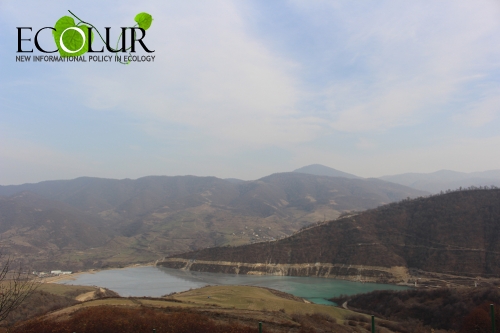

EcoLur
Shnogh community is concerned with fast rate of filling Teghout tailing dump. 
'As far as I know, the contract for the tailing dump is for 50 years, but it has been filled in several years. There is an area, we call it orchards, where now the tailing dump is – two years ago an enormous dam was constructed, but now it's already full. If an earthquake happens, can I be sure that the dam will sustain?' said Hovhannes Sahakyan, Ex Head of Shnogh community. 
'If a year is rainy, all the tails will be washed away to the village,' Shnogh villager Levon Alikhanyan said. The same is mentioned in 'Armenia: Strategic Mineral Sector Sustainability Assessment' report prepared by the World Bank. The report says the Rate of Rise (RoR) for the structure varies during the dam life, but is considered to be extremely high (based upon available information) and is well beyond the maximum recommended RoR for upstream raises, particularly in relation to the town of Shnogh which lies in the downstream zone of a failure scenario.'
In reply to EcoLur's inquiry on the report, Information and PR officer of Vallex Group developing Teghout copper and molybdenum mine informed, 'The tailing dump of Teghout CJSC was designed by 'Lernametallurgy Institute' CJSC and complies with the existing construction and seismic standards operating in Armenia. What about its sustainability, still in July 2015 this matter was discussed with the participation of the European bank specialists and an agreement was reached to continue operating the tailing dump in parallel with implementation of monitoring to specify the filtration and physico-mechanical properties of the tails. Currently these works are in progress. There are 8 piezometers installed to control the horizon of filtration water in the prizma body in the dam: once a month samples are taken from the dam bank and the pond to determine their physico-mechanical properties. As soon as there are sufficient data on properties of the tails, their volumes will be compared with the data in the project and if needed, dam recalculation will be carried out. It should be mentioned that all tailing dumps operating in the Republic of Armenia were designed by 'Lernametallurgy Institute' CJSC and comply with the requirements of the abovementioned normative standards.
Another matter connected with tailing dump is the pollution of the Shnogh River. In reply to EcoLur's enquiry what kind of measures the company takes to prevent the pollution of the Shnogh River, 'Vallex' replied, 'The pollution of the Shnogh River is conditioned with heavy precipitation and quick melting in January-February 2016 and in order to prevent similar situations in future the number of pumps in the circulating pumping station has been added with one fixed and one reserve pumps.'
Even after this reply Shnogh residents continue complaining of river pollution, 'The river is getting more and more polluted. As a matter of fact, tails are let out at night. A part of the village makes use of the river and they incur economic damage. For example, I have many hectares of land areas in the area, which I can't water, as they are located down the dam,' Levon Alikhanyan said. Teghout tailing dump is located in the gorge of the Kharatanots River, which includes around 110 ha. According to the EIA of Teghout copper and molybdenum mine, the dam is designed fir 173.6 million cum of tails, which will be accumulated during 28 years in case of annual productivity of 7 million tons.
 |
 |
December 06, 2016 at 12:12
